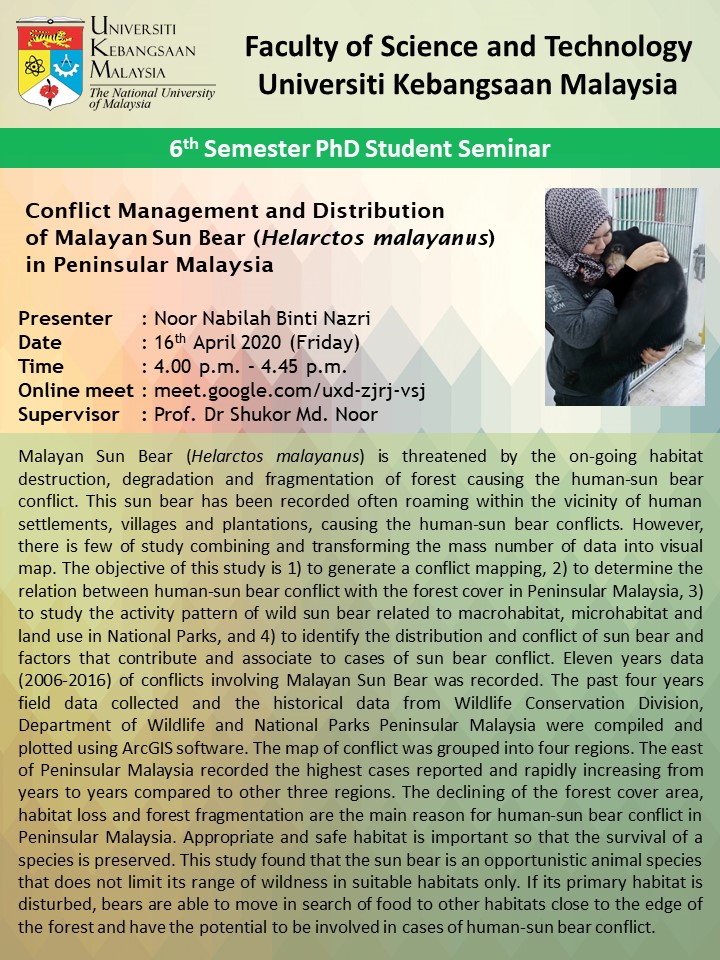6th Semester PhD Student Seminar April 2021
Structural and Functional Characterisation of Fungal Carboxylic Acid Reductases
Presenter: Jonathan Ling
Date: 16 th April 2020 (Friday)
Time: 3.15 p.m. 4.00 p.m.
Online meet: meet.google.com/uxdzjrjvsj
Supervisor: Assoc. Prof. Dr. Farah Diba Abu Bakar
Synopsis
Carboxylic
acid reductases ( are a family of multi domain enzymes that catalyse the ATP and NADPH dependent reduction of carboxylic acids to their corresponding aldehydes They are emerging as promising biological solutions in the synthetic chemistry toolbox for the organic synthesis of aldehydes and their follow up products from economic carboxylic acid precursors via a sustainable, selective and facile platform. The biocatalytic potential of CARs, and the desire to improve their catalytic properties, have inspired burgeoning interest in the exploration of these enzymes. The CAR enzyme class as a whole, however, is still poorly understood All existing functional and structural information of the CAR enzyme class has been hitherto gleaned from a limited pool of CAR enzymes the majority of them bacterial in origin There is thus significant impetus to augment existing information by generating more diversity in this enzyme class Here, we leveraged the CAR sequence space via the genomic enzymology strategy, in which sequence similarity networks, genomic neighborhood networks and phylogeny partitioning were used to focus selection of representative targets This led to the identification of 59 new CAR sequences from 11 model species spread throughout the fungal kingdom These representative CARs were amplified from cDNA, assembled into expression constructs, heterologously produced in Escherichia coli and biochemically characterised in vitro From the pool of targets, we present two functionally distinct CARs from Pycnoporus cinnabarinus Both possessed more pronounced and narrower substrate preferences, and also lower catalytic activity when compared to previously reported CARs Together with the quintessential CAR from Neurospora crassa these CARs were selected for structural studies on the basis of their disparate catalytic profiles A number of structural biology approaches were utilised to reduce conformation heterogeneity of CARs Preliminary crystallisation screens of the CAR adenylation domains yielded a number of conditions in which crystals were obtained Taken together, these current findings support the view that the CAR enzyme class is functionally more diverse than previously recognised. Further work on the recombinant expression, functional and structural characterisation of the remaining CARs is ongoing Our efforts to explore the sequence structure function realm of fungal CARs will hopefully decipher the molecular determinants of functionality and catalysis in the CAR enzyme family, and expedite holistic understanding of the fundamentals of enzyme catalysed carboxylate reduction.
Conflict Management and Distribution of Malayan Sun Bear Helarctos malayanus ) in Peninsular Malaysia
Presenter : Noor Nabilah Binti Nazri
Date : 16 th April 2020 (Friday)
Time : 4.00 p.m. 4.45 p.m.
Online meet : meet.google.com/uxdzjrjvsj
Supervisor : Prof. Dr Shukor Md. Noor
Synopsis
Malayan
Sun Bear He larctos malayanus is threatened by the on going habitat destruction, degradation and fragmentation of forest causing the human sun bear conflict This sun bear has been recorded often roaming within the vicinity of human settlements, villages and plantations, causing the human sun bear conflicts. However, there is few of study combining and transforming the mass number of data into visual map. The objective of this study is 1 to generate a conflict mapping, 2 to determine the relation between human sun bear conflict with the forest cover in Peninsular Malaysia, 3 to study the activity pattern of wild sun bear related to macrohabitat, microhabitat and land use in National Parks, and 4 to identify the distribution and conflict of sun bear and factors that contribute and associate to cases of sun bear conflict Eleven years data 2006 2016 of conflicts involving Malayan Sun Bear was recorded. The past four years field data collected and the historical data from Wildlife Conservation Division, Department of Wildlife and National Parks Peninsular Malaysia were compiled and plotted using ArcGIS software The map of conflict was grouped into four regions. The east of Peninsular Malaysia recorded the highest cases reported and rapidly increasing from years to years compared to other three regions The declining of the forest cover area, habitat loss and forest fragmentation are the main reason for human sun bear conflict in Peninsular Malaysia Appropriate and safe habitat is important so that the survival of a species is preserved This study found that the sun bear is an opportunistic animal species that does not limit its range of wildness in suitable habitats only If its primary habitat is disturbed, bears are able to move in search of food to other habitats close to the edge of the forest and have the potential to be involved in cases of human sun bear conflict



